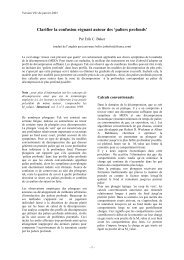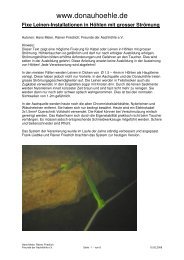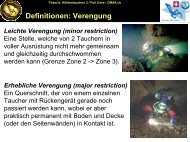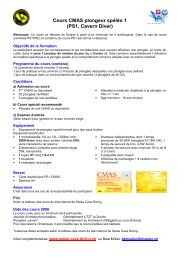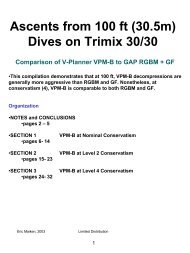cave diving and the nss - bei Swiss-Cave-Diving
cave diving and the nss - bei Swiss-Cave-Diving
cave diving and the nss - bei Swiss-Cave-Diving
You also want an ePaper? Increase the reach of your titles
YUMPU automatically turns print PDFs into web optimized ePapers that Google loves.
32 CAVE DIVING COMMUNICATIONS<br />
ments of streamlining <strong>and</strong> dangly avoidance, it must be stored<br />
somewhere, usually ei<strong>the</strong>r in a BC pocket or zippered dive pouch.<br />
This means that before use, it must be located <strong>and</strong> removed, which<br />
is not always as easy as it sounds, especially while trying to maintain<br />
proper trim. The slate will ei<strong>the</strong>r be attached to <strong>the</strong> pocket with<br />
some kind of cord, or be free st<strong>and</strong>ing. If it is attached by a cord,<br />
rest assured that you can get tangled in <strong>the</strong> cord; if it is free<br />
st<strong>and</strong>ing, you can drop it. If <strong>the</strong> bottom is very deep or silty, <strong>and</strong><br />
<strong>the</strong> slate also happens to be attached to your decompression<br />
tables, you could be in serious trouble. (Murphy's Law dictates that<br />
<strong>the</strong> likelihood of your dropping it is directly proportional to <strong>the</strong> difficulty<br />
of retrieving it.) Tiny arm slates are now commercially available,<br />
<strong>and</strong> while <strong>the</strong>y have <strong>the</strong> triple advantage of <strong>bei</strong>ng quickly <strong>and</strong><br />
easily accessible, <strong>and</strong> attached to <strong>the</strong> diver, <strong>the</strong>y are very limited<br />
in writing surface, <strong>and</strong> it may be somewhat difficult to pass your<br />
arm back <strong>and</strong> forth.<br />
There are times, of course, when it will be entirely appropriate<br />
to spend <strong>the</strong> necessary time getting oriented <strong>and</strong> stabilized in order<br />
to write a clear message. But <strong>the</strong> importance of <strong>the</strong> message<br />
should be weighed against <strong>the</strong> disadvantages of communicating it<br />
by slate. For example, if you do not feel comfortable in <strong>the</strong> <strong>cave</strong>,<br />
it is not necessary to write a long essay of apology explaining this<br />
to your buddy. All you have to do is signal "Surface." He may want<br />
to know why, <strong>and</strong> even ask to see your pressure gauge (or even<br />
surreptitiously look at him himself), because if it's something o<strong>the</strong>r<br />
than a routine air turn, it may mean that you are experiencing some<br />
difficulty he should be alerted to. But he has no right to dispute<br />
<strong>the</strong> matter with you. If he does, <strong>the</strong>n ... as Confucius say: "Most<br />
honorable dive partner truly have most unworthy buddy." The NSS-<br />
CDS motto is that "Any diver may call any dive at any time for any<br />
reason." And <strong>the</strong> decision to terminate <strong>the</strong> dive for one team member,<br />
terminates <strong>the</strong> dive for all.<br />
Chapter Six<br />
TOUCH CONTACT<br />
Many people wonder why we go <strong>cave</strong> <strong>diving</strong>. "What is <strong>the</strong>re<br />
to see?" <strong>the</strong>y ask. And you answer, "Water. Rock. The occasional<br />
troglobyte or fish." "Is that all?" <strong>the</strong>y ask. You smile <strong>and</strong> shrug<br />
your shoulders. "But when <strong>the</strong> visibility drops to only a few feet,<br />
<strong>and</strong> you can't see a blessed thing, <strong>the</strong>n why do you do it?" That's<br />
when you tell 'em about <strong>the</strong> "treasure."<br />
We advise <strong>cave</strong>rn divers to turn <strong>the</strong>ir dives when <strong>the</strong> visibility<br />
deteriorates below forty feet. In contrast, many a <strong>cave</strong> doesn't<br />
begin with as much as four feet of visibility, let alone forty. <strong>Cave</strong><br />
dives involving scientific data collection, exploration, mapping, <strong>and</strong><br />
<strong>the</strong> search for dry <strong>cave</strong> beyond a sump do not always afford <strong>the</strong><br />
luxury of crystal clear water. They may require precision techniques<br />
in very poor or even nonexistent visibility. Obviously, <strong>the</strong>se<br />
conditions are going to place serious limitations on <strong>the</strong> use of light<br />
<strong>and</strong> h<strong>and</strong> signals, <strong>and</strong> even strain <strong>the</strong> effectiveness of <strong>the</strong> buddy<br />
system itself.<br />
Where <strong>cave</strong>rn divers <strong>and</strong> beginning <strong>cave</strong>-<strong>diving</strong> students are<br />
encouraged to remain within arm's reach of <strong>the</strong> line at all times,<br />
seasoned <strong>cave</strong> divers will routinely<br />
swim far<strong>the</strong>r away from<br />
<strong>the</strong> line under conditions of good<br />
visibility. Frequently, this will afford<br />
protection from current, a<br />
better view of <strong>the</strong> <strong>cave</strong>, etc.<br />
However, as visibility drops, <strong>the</strong><br />
<strong>cave</strong> divers will get correspondingly<br />
closer to <strong>the</strong> line <strong>and</strong> to<br />
each o<strong>the</strong>r.<br />
Good visibility can deteriorate<br />
during <strong>the</strong> course of a dive




